| Article ID | Journal | Published Year | Pages | File Type |
|---|---|---|---|---|
| 4466952 | Palaeogeography, Palaeoclimatology, Palaeoecology | 2012 | 12 Pages |
The varved sediments of Lake Van provide a high-quality continental archive of seasonal to decadal-scale climate variability. In order to read the natural record, modern varve formation was studied on the basis of (1) remotely-sensed total suspended-matter (TSMrs) concentrations; (2) time-series of particle flux and water temperatures; and (3) turbidity, temperature, and oxygen profiles. TSMrs, validated by contemporaneous water-column sampling, shows great temporal and lateral variations (whitings and turbidity plumes). From 2006 to 2009, sequential sediment traps recorded high particle fluxes during spring and fall, medium fluxes during summer, and almost zero flux during winter. The mean total mass flux of 403 mg m− 2 day− 1 comprised 33% (seasonally up to 67%) calcium carbonate, 7% aquatic organic matter, 6% biogenic opal, and 54% detrital minerals. The CaCO3 fluxes are controlled by river discharge (precipitation and snowmelt) during spring, by high productivity during summer, and by river discharge (precipitation before snowfall starts) and mixing during fall. In November 2007, an anomalously high CaCO3 flux occurred as a result of a warm water surface supersaturated with calcite coinciding with an anomalous runoff event. The results demonstrate that the couplets of light and dark laminae in the short sediment cores are true varves representing spring–summer–fall and winter conditions, respectively. Consequently, varve formation can be linked to the seasonal climate pattern, providing a calibration that can be used to interpret the partially varved paleo-record of Lake Van and related environmental processes.
► Satellite data and sediment traps quantify the annual particle cycle in Lake Van. ► CaCO3 flux is mainly controlled by runoff; e.g. by rainfall and snowmelt. ► The annual particle cycle is deposited as varves. ► Light laminae are produced from spring to fall, and dark laminae in winter. ► The varved sediment offers a seasonally-resolved paleoenvironmental archive.
